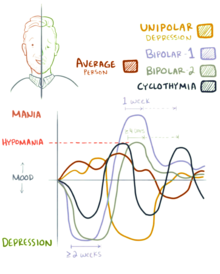Not a milder form of Bipolar Disorder I. A person with bipolar disorder will switch between extreme excitement or mania and depression.
/379962-bipolar-disorder-symptoms-and-diagnosis-5b1150af3418c60037552e47.png) Symptoms And Diagnosis Of Bipolar Disorder An Overview
Symptoms And Diagnosis Of Bipolar Disorder An Overview
The obvious one is that bipolar disorder and depression both involve depressive episodes but theres more.

Depression and bipolar disorder similarities. Bipolar disorder and depression can both be treated. Here we compare clinical course variables and depressive symptom profiles in a large sample of individuals with major depressive disorder n593 and bipolar disorder n443. The depressive phase of bipolar disorder shares many similarities to regular depression including prolonged sadness inability to concentrate loss of energy difficulty sleeping and thoughts of suicide.
One type of psychiatric symptoms that can affect both certain types of bipolar and depression is that of psychosis it is possible to be diagnosed with psychotic depression and in the more intense bipolar I patients may experience psychotic symptoms at the very heights of mania or the lowest points of depression. Major depressive disorder and bipolar depression. Bipolar disorder and depression are mental health conditions that share similar features but are separate medical conditions.
Bipolar disorder causes strong shifts in energy mood and activity levels. Consider causes symptoms effects on daily activities impact on relationships and treatment options for each disorder. Periods of hypomania and depressive.
Discuss the similarities and distinctiveness of each disorder. Bipolar Disorder II symptoms include. Diagnosing either bipolar disorder or major depressive disorder is.
Cyclothymic Disorder symptoms include. To differentiate between the two disorders it helps to understand the symptoms of each one. Clinical characteristics associated with a bipolar course included the presence of psychosis diurnal mood variation.
Hypomanic episodes are similar to manic episodes though they are not as severe. It can cause longer periods of depression. These symptoms are distinctly unlike those experienced during the depressive phase of bipolar disorder or by people suffering from a major depressive disorder.
What do bipolar disorder and depression have in common. Major depression and bipolar disorder can both cause highly disabling and unpleasant episodes of depression but in the case of bipolar disorder those episodes will eventually give way to manic states that can be every bit as debilitating. Left untreated the risk of poor outcomes including suicide are high in both depression and bipolar disorder.
The clearest findings are a genetic distinction between type 1 bipolar and type 2 bipolar and the greater similarity of type 2 bipolar to major depressive disorder said first author Jonathan. The main difference between the two is that depression is unipolar meaning that there is no up period but bipolar disorder includes symptoms of mania. A minimum of at least one hypomanic episode.
The diagnostic boundary between recurrent unipolar depression and bipolar disorder may not be clear-cut and further the symptoms of unipolar depression compared with bipolar depression although similar are subtly different. Major depression and bipolar disorder. Bipolar Type II consists of having a depressive episode as well as at least one hypomanic episode.
Bipolar disorder is easily confused with depression because it can include depressive episodes. Bipolar Type I consists of having a manic episode that lasts at least 7 days as well as a depressive episode. Attention deficithyperactivity disorder and autism spectrum disorder.
One major depressive episode. Depression with a mix of depressive symptoms and manic symptoms at the same time. Reduced NAACr ratio at the left WMP lobe indicated the dysfunction of neuronal viability in deep white matter in both MDD and BD patients who shared similarities of brain biochemical abnormalities which might imply an overlap in neuropathology of depression.
Bipolar 1 disorder can cause you to alternate between depressive and manic episodes. If you have bipolar 2 disorder it means youve had at least one bout of major depression.

